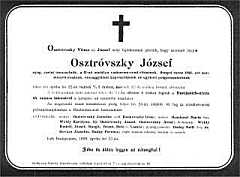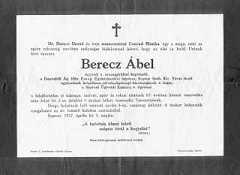Death notices of József Osztróvszky, great-great-grandfather of the author, and Ábel Berecz, a great-uncle of the author.
Format: Single black-bordered sheet varying from postcard size to a full-page. (If large, it was probably folded for mailing.)







Typical Content of Death Notices.
I will review the four major parts of a Death Notice, and in the notes provide translations of both examples and some commentary on the context of each. Hopefully, this will permit you -- given an adequate translation -- to evaluate and learn from death notices found in your own family. Note that most of a death announcement is one long sentence essentially saying:
(1) I'm Jane Doe and I'm letting you know that my husband (2) John Doe who was a great guy and did all this wonderful stuff (3) died today at noon and will be buried in the church cemetery the day after tomorrow at 2PM; (4) he is also mourned by all these relatives and friends -- may he rest in peace.
It's (almost) as simple as that. Much of the pertinent family history information jumps out at you, but don't forget the many minor facts and implications that can be hidden among a few simple words.
1. Authors of the Notice. In general, a death notice is prepared and sent by a surviving spouse and/or children. This introductory phrase identifies the closest living relatives of the deceased, and may tell you a little about the family "pecking order" and their feelings about status, religion, and possibly other issues.
2. Accomplishments of the Deceased. After providing the name of the deceased in big, bold type, his/her accomplishments are briefly itemized. Note: because of the status of women in past times, it's likely that this part of a woman's death announcement (other than her name, of course) will be omitted. Remember also that people usually don't speak badly of the dead. So don't expect to learn that he beat his wife or robbed his clients blind ... all you'll hear is the good stuff.
3. Facts Concerning the Death and Funeral. This is usually a straightforward recitation of the facts: date and time of death (usually not the cause) and date, time, and place of the funeral. There may be something about calling hours.
4. The List of Mourners and Other Information. Toward the bottom is the list of mourners (gyászolják) -- though in one of these examples this was not included due to the dearth of close relatives, a statement of the place and date the announcement was being published (the date is usually the date of death), and a nice epitaph. At the very bottom in small type is the name and address of the printshop, which is almost always not relevant ... unless you have a printer in your family.
